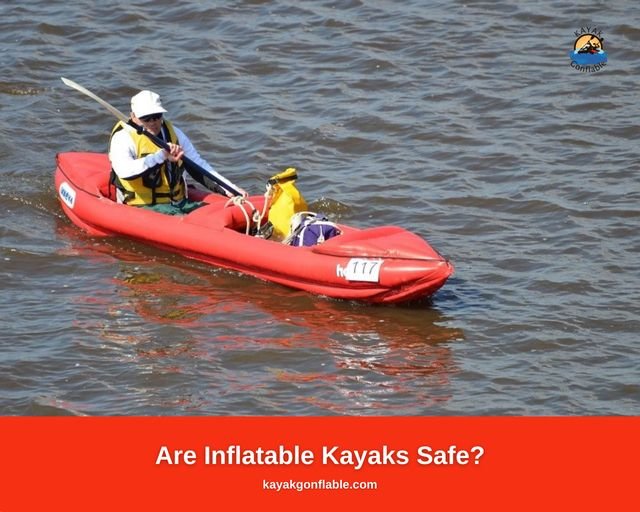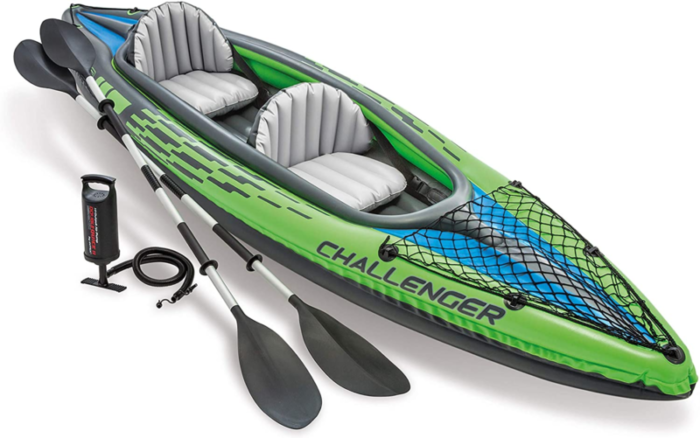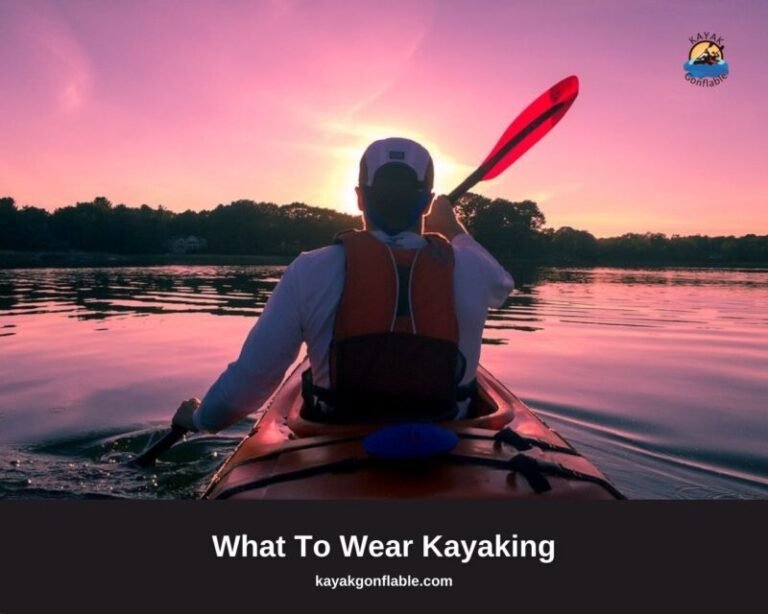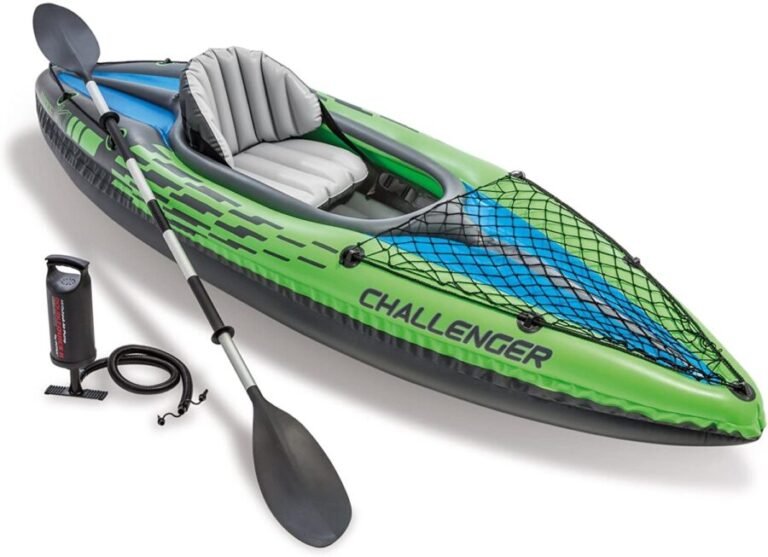Are Inflatable Kayaks Safe?

How Safe Are Inflatable Kayaks?
Whenever we hear that something’s inflatable, what comes to mind is that it’s soft, blown up, and easy to pop. And yet we have inflatable kayaks.
The first time I heard of inflatable kayaks, the first thing that came to my mind was ‘Surely that can’t be safe. A lot of people have similar concerns about the safety of an inflatable kayak and whether it can perform as well as a hard-shell kayak.
If you also experienced this, you’re in the right place because this article will put an end to the misconceptions about inflatable kayaks.
What Is An Inflatable Kayak?
Simply, an inflatable kayak is a kayak that needs to be pumped up with air. If you want a more advanced definition then it’s a multi-layered PVC (polyvinyl chloride) boat with meticulously built air chambers to give buoyancy and allow them to float on water.
It may have other features and accessories that aren’t inflatable, such as the seats or the foot support, but as long as it needs to be blown up then it is an inflatable kayak. There are several different types of inflatable kayaks made to suit your personal padding style needs and preferences.
A self-bailing kayak is built for fast-flowing water conditions. It also has the added feature of having drainage holes to avoid your kayak being flooded with water. However, this means that you should expect your seat to get wet.
A sit-in kayak with a low center of gravity provides great stability and is very similar in design to the hard-shell kayak. Like a hard-shell kayak, the sit-in kayak has a cockpit that you can sit in.
It has room in the hull for storing equipment and supplies and it has the added advantage of being warmer in cold weather.
A sit-on kayak is perfect for inexperienced kayakers and kids since it’s very easy to use and master. Its deck is considerably large and open.
This type of inflatable kayak is called sit-on because instead of having your legs encased in a cockpit as in regular sit-in kayaks, you sit on top of these kayaks.
Tandem kayaks are for kayakers who enjoy paddling with company. They are 2-person kayaks perfect for couples seeking some alone time with nature or friends looking for their next adventure.
They are designed with two seats with the added feature of some extra length which makes the kayak more stable.
Benefits of An Inflatable Kayak
Besides the major advantage of an inflatable kayak being cheaper than a hard-shell kayak, there are several other benefits you’ll enjoy when using one.
Portability: One of the greatest advantages that an inflatable kayak has over a hard-shell kayak is the fact that it is so easy to carry and move around.
An inflatable kayak is generally much lighter than a hard-shell kayak and once all of its compartments have been deflated, they can then be rolled up and folded tightly into a transport bag that you can carry around wherever you go.
This makes it the perfect option when vacationing to places where it may be hard to rent kayaks since inflatable kayaks can either be shipped or taken along as simple baggage.
The fact that it can also be kept inside a transport bag, makes it much more storage-friendly, meaning you can just toss it in a cabinet or the basement whenever it’s not in use.
Stability and Rigidity: Inflatable kayak is incredibly stable, strong, and rigid but make sure they’re well inflated before use. If not, you may have a hard time staying afloat in the kayak.
To ensure that they remain extremely stable while on the water, most inflatable kayaks are designed with a metal framework or with thin inflated segments that function as rods. Both serve the same function as stabilizers in the kayak.
However, if you plan on using an inflatable kayak on the ocean or for whitewater kayaking, then it’s advisable to use the kayaks that have been designed for this specific purpose.
Durability: As mentioned before, an inflatable kayak is made of several layers of PVC which makes it very durable. The PVC used in making these kayaks is usually coated making them very tough.
Some kayaks have been built with even stronger materials, such as Hypalon, which will make it last longer than a PVC inflatable kayak.
Most inflatable kayaks last for about 7 to 10 years on average, and this duration can even double to 20 years if the kayak is given the proper care and maintenance.
So, if you really want the best from your kayak, you need to take good care of it.
Inherent buoyancy: One of the best things about an inflatable kayak is the fact that, due to its multiple air-filled chambers, they are incredibly buoyant. This means no matter what happens, they won’t sink.
Even when they get filled with water, they’re so buoyant that they’ll stay afloat, and since most inflatable kayaks are self-bailing, the water will drain right out.
And due to their wider design, they’re incredibly hard to capsize. Inflatable kayaks also have a higher load capacity, making them perfect for angling.
Beginner-friendly: Not only is an inflatable kayak perfect for kids, but it’s also the go-to kayak for beginners or inexperienced kayakers.
If you’re someone with zero experience, an inflatable kayak would be a great starting point. Besides the fact that it’s lightweight, very stable, durable, and it won’t sink, you also don’t have to break the bank to purchase one.
I mean… what’s there not to love.
Are Inflatable Kayaks Safe?
One of the major concerns that people have about using an inflatable kayak is whether it will pop or puncture while on water, but that’s a huge misconception.
As mentioned before, inflatable kayaks are made of incredibly strong and tough materials such as PVC and Hypalon.
These materials are then layered and given a protective exterior UV coating and abrasion-resistant reinforcements. All of these factors work together to ensure that the kayak is as puncture-proof as possible, and can handle a wide variety of abuse.
Check out this video below to see just how much pressure an inflatable kayak can handle
Even though inflatable kayaks have been designed to be highly puncture-resistant, leaks and tears can still happen.
There’s really no way of knowing what kind of rock or sharp objects the kayak will encounter while on water.
So, if you’re out on the water and you happen to get a tear on the floor of the kayak, don’t panic because the kayak was designed with these situations in mind.
Inflatable kayaks have at least three air chambers, so in the event that one does get punctured then the other air chambers will be able to function till you’re able to paddle to land.
Remember, even though it’s possible for an inflatable kayak to be punctured, there’s a very slim chance that it will happen.
However, don’t worry if you do find yourself with a punctured kayak, the good news is that punctures are an easy fix. There’s no need to call on a professional team of specialists to fix the hole.
With the help of a patch kit, you can repair the kayak in no time. For a guide on how to do this, check out the video below
Categories of Inflatable Kayaks
Although inflatable kayaks have been designed and built in such a way that it puts the safety of their users first, it is also important that the proper kayak is used for the appropriate activities.
There are three different categories of inflatable kayaks each constructed in its own special way to perform in specific scenarios and water conditions.
Category 1 inflatable kayaks are constructed with only a single layer of PVC. This type of kayak is preferable for those on a budget looking to get something cheap typically ranging between $80 and $250. They’re great for calm waters and short paddles, although they’re known to be slow and harder to control and maneuver.
Category 2 inflatable kayaks are more expensive, costing between $350 to $800. Although, like category 1 kayaks, they only have a single layer of PVC, however, they also have the added feature of having the PVC encased in a protective fabric making them more puncture and UV-light resistant. Category 2 kayaks are also pretty good for whitewater kayaking.
Category 3 inflatable kayaks are the ones you see being used by experienced and committed kayakers or by those who don’t mind their higher cost.
However, with the higher cost comes a lower chance of the kayak being punctured. This is due to the drop stitch technology that they possess which makes it almost comparable to a hard-shell kayak.
Category 3 kayaks are also faster, sturdier, and more rigid than other inflatable kayaks.
Tips When Using An Inflatable Kayak
Now that all doubts have been cleared and it has been established that inflatable kayaks are safe for use, here are some tips and pointers to help you get the most out of your kayak:
Maintenance: Although an inflatable kayak is very durable, it still needs to be properly maintained for it to last as long as possible. One way or maintaining the UV protective layer on the skin of the kayak is to apply UV protectant spray.
Cleaning the valves regularly will prevent a buildup of sand which might cause the valve to get clogged during inflation, potentially causing it to explode.
When inflating the kayak, you must pay attention to the air pressure. Ensuring that the inflatable kayak is not over or underinflated.
An over-pumped kayak will cause damage to its seams, while an under-inflated kayak will experience losses in rigidity and speed. Check the owner’s manual and follow the guidelines provided.
In hot weather, remember to let some air out of the kayak to prevent an increase in the air pressure in the kayak.
Drying: After a day of paddling it’s important that the kayak is properly packed away to avoid damage. It’s important to clean, rinse, and dry the kayak before packing it into a transport bag.
Cleaning the kayak of dirt and debris prevents the surface of the kayak from getting debrided which can remove its protective layer and increase its chances of being punctured.
Rinsing the kayak removes any leftover residue and debris that you may have missed. Rinsing also prevents erosion from salt or any other chemicals that might be present in the water you are in.
After rinsing, the kayak must be properly dried. If not, the moist materials may prompt mold and mildew growth, which may degrade and thin out the PVC the kayak is made of.
Storage: How an inflatable kayak is stored is vital if you want it to have a long lifespan. It’s important that the kayak is stored in its deflated form to protect its seams and its skin.
It will also help reduce the strain on its valves. Once the kayak has been properly deflated then the kayak needs to be rolled up or folded up. It doesn’t really matter which one you choose to do, just make sure that you do it slightly different manner each time.
If not, seams may form on the kayak’s skin, making the material weaker at these points and more likely to puncture or tear. Once the kayak has been folded or rolled up and put into a transport bag, to avoid mold or mildew growth, it should be stored in a cool, dry location.
If you’d prefer to keep it outside, cover it up to prevent moisture and debris from settling on the skin. Although everything comes with its own risk, I hope I have been able to show you inflatable kayaks are very tough, safe, and reliable.
Not only are they portable, lightweight, and beginner-friendly, they’re very durable and cheaper than a hardshell kayak. Trust me on this and try getting an inflatable kayak for your next paddling adventure, you won’t regret it.






